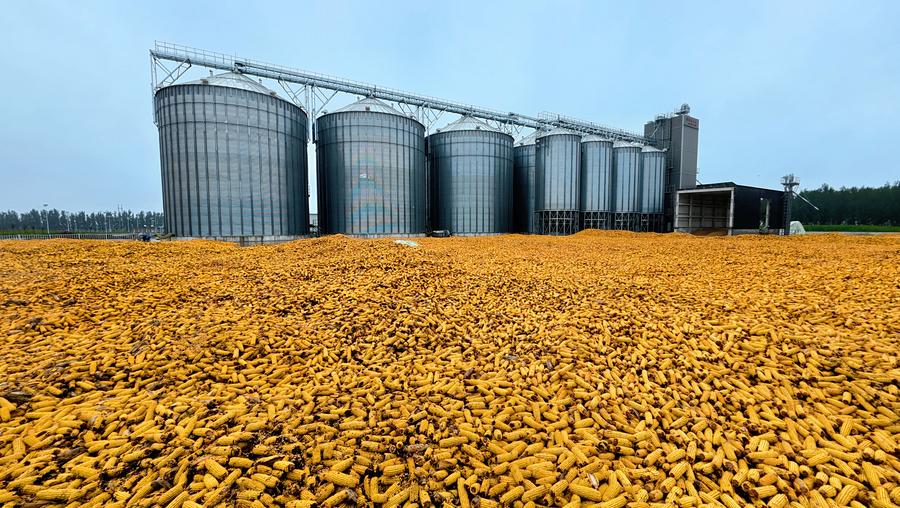




- BRNN
- BRI News
- BRNN News
- Database
Official Documents Polices and Regulations
Inter-government Documents International Cooperation BRI Countries
Business Guide Economic Data BRI Data
Trade
Investment Projects Latest projects
Cases - Content Pool

Powered drying facilities for harvested corns are seen in Dezhou city, east China's Shandong Province, Oct. 9, 2025. (Photo by Zhao Huhao/Xinhua)
China's national grain storage capacity has exceeded 730 million tonnes, up 58 million tonnes from the end of the 13th Five-Year Plan period (2016-2020). In 2024, the total industrial output value of the country's grain enterprises surpassed 4 trillion yuan (about $561.5 billion), with production, processing, and sales more smoothly connected than ever.
In Gucheng town, Qingfeng county, Puyang city, central China's Henan Province, major grain grower Zhou Jianshi was busy assembling a rotary tillage and seeding machine. "It can do everything—sowing, covering the soil, compacting, and laying drip irrigation lines," he said.
Standing on the field ridge, Zhou opened a smart farming platform on his smartphone that displayed real-time soil moisture data. At 55, he now manages 3,500 mu (about 233 hectares) of farmland. Just five years ago, he was providing farm machinery services; today, he's a well-known grain grower in the area.
This spring, Zhou's cooperative partnered with Henan Agricultural University to set up a science and technology backyard. In the high-standard farmland, drip irrigation tubes deliver water and nutrients directly to crop roots. Drones patrol the fields and spray pesticides with pinpoint accuracy.
"In the past, it took 10 people to water 300 mu of land. Now, I just tap my phone," Zhou said. He said this year's wheat yield reached 709 kilograms per mu, while fertilizer and pesticide use fell by 20 percent.
In June this year, Zhou delivered more than 800 tonnes of wheat to China Grain Reserves Group's (Sinograin) warehouse in Puyang and nearby storage sites.
Puyang is a major grain production base, said Ma Junhua, deputy general manager of Central Grain Reserve Puyang Direct Warehouse Co., Ltd. affiliated to Sinograin, adding that Puyang's total winter wheat output is around 1.7 million tonnes. Ma said the company has supplied 18,000 tonnes of grain to the market so far this year.
Beyond just improving production, efforts are also being made to expand the variety of products wheat is being processed into.
"In the past, flour mills produced just bran and flour. Today, a single production line can churn out flour for a wide range of uses," said Zhao Qinghua, head of COFCO Flour Industry (Puyang) Co., Ltd.
The flour has become key ingredients for local food processors. At Kaililai Food Co., Ltd., flour is mixed with eggs, cream, and other ingredients, then kneaded, shaped, and baked into golden loaves. Five packaging machines seal the fresh bread, making them ready for delivery nationwide.
Cao Gaozhang, head of the company, said the company now produces more than 300 varieties of snacks in eight main categories, using over 30,000 tonnes of flour each year. Monthly sales of new products have reached 20 million yuan, and some have made their way into overseas markets.
According to an official from the Department of Agriculture and Rural Affairs of Henan, the province's summer grain output exceeded 37.5 billion kilograms. By extending the industrial chain, enhancing the value chain, and strengthening the supply chain, Henan has built a trillion-yuan modern food industry cluster, bringing every grain not only to Chinese kitchens, but also to tables around the world.

Tel:86-10-65363107, 86-10-65368220, 86-10-65363106